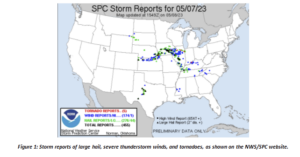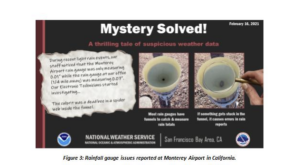Storm reports are one of the most used tools in forensic storm damage assessments for insurance claims and litigation following a weather event. These reports are generally published by the National Weather Service and can be found in both preliminary format at the Storm Prediction Center’s website (among other, third-party sites), as well as in the National Oceanic and Atmospheric Administration’s (NOAA) Storm Events Database.

Storm reports can also apply, in a broader sense, to weather reports that are not always published by the National Weather Service, i.e., a wind measurement from a private weather station or a video of a hailstorm from a local TV station. While not published by NOAA, these reports are often used in forensic storm analyses, as they represent (to varying degrees) observed weather conditions. In fact, some precedent has been set for using social media weather reports as official storm reports (Blair and Leighton 2012), but several instances of fake or otherwise unrepresentative reports have also plagued this system.

What Are Not Storm Reports?
Meanwhile, automated weather reports utilized widely in the insurance industry are generally not storm reports. Some proprietary services do repackage this observed “ground-truth” in their products. While useful and accurate at times, some of these services also repackage non-quality-checked data from sources and weather stations that are suspicious, or simply just erroneous. Routinely, these suspect and/or erroneous reports lead to the selection of incorrect dates-of-loss, disputes between carrier and policyholder, and even bad-faith litigation.
Storm Report Inaccuracies
Some online weather sources offer free databases of wind speed measurements from personal weather stations (PWSs). These sources are routinely used in forensic storm investigations—usually by adjusters and professional engineers assigned to claims. However, many of these PWSs are not properly sited, unlike airport weather sensors, which often leads to under-measured wind speeds. In other cases, these PWSs are subject to artifactual wind readings that are anomalously high and clearly erroneous. While it isn’t always clear why this occurs, electronic malfunctions/surges, leaf-blowers, direct human interaction, and yes, even the flapping of bird wings (perched on the sensor), are all plausible (and actual?) causes. Fortunately, it is rare that the National Weather Service will publish such erroneous reports, and they generally occur under fair weather conditions, making the errors very easy to detect by a meteorologist.
Rainfall reports can suffer errors like those in wind reports if not properly sited, such as near buildings or under trees, resulting in an under-measurement of rainfall. While the gauge positioning may be optimal when installed, growth of vegetation may make the unsatisfactory over a period of time. Because they are outside, PWSs occasionally incur rain collector blockages such as bird nests, spider webs, insects, sticks, leaves, or other objects blocking the gauge from functioning optimally (see Figure 3). National Weather Service-standard manual rain gauges often provide the highest quality rain information, such as those required to be utilized by the CoCoRaHS Network, as these gauges are manually checked and read daily by trained volunteers and weather observers.
Regarding storm reports that are published by the National Weather Service, there is a library of literature regarding issues with even these seemingly “official” reports (or lack thereof), especially regarding hail reports and wind reports. For example, Blair and Leighton (2012) found that in a surveyed hail swath (with many stones of 4.00-inches) in Wichita, Kansas in 2010, of 60 surveyed residents, not a single witness reported these giant hail observations to the National Weather Service, despite visible significant damage occurring.

Of storm reports that do occur and are published, Blair et al. (2011) found that “in many cases, it is suspected that [Storm Events Database] under-represents the maximum-sized hail of the storm,” and “reporting errors by the observer or second-hand relayed reports may contribute to errors within [the Storm Events Database]. A tendency for observers to report estimated hail sizes, such as comparing hail to commonly sized objects instead of measuring the explicit size of hail, also may result in inaccurate size information in the database (Jewell and Brimelow 2009; Baumgardt 2011).”
Amburn and Wolf (1997) stated, regarding storm reports from the National Weather Service, that “verification processes are designed to efficiently verify warnings, not to satisfy scientific studies.” In forensics, we are conducting a scientific study, not verifying a warning. This poses a stark difference regarding the use of storm reports for operational meteorology and their use for forensic meteorology.
Witt et al. (1998) found that 29% of hailstorm reports in the Storm Events Database “did not correlate well with the radar data.” Ashley et al. (2019) noted that this also occurred at times with wind reports.
Blair et al. (2017) found that there was a “high degree of uncertainty that hail reports obtained during NWS warning verification efforts are representative of the true hailfall of a given storm.” Also, in the same study, they reported that “over 30% of sampled severe storms had no corresponding Storm Data reports, which provides an initial quantitative answer raised by Cecil (2009) with respect to the unknown percentage of severe hailstorms that go undocumented.”
For example, nocturnal severe weather reporting may be limited in scope and efficiency (based on Ashley et al. 2008). There can be fluctuations in reporting based on a storm’s track through rural versus urban areas (also stated in Cecil 2009). Even in-house practices of various National Weather Service offices will result in a fluctuation of reports and different reporting procedures, as mentioned in Doswell et al. (2005).
Also, in Doswell et al. (2005), it was found that “observers of severe thunderstorms also provide estimates of peak wind gust speeds, and when those estimates are available, they are entered into the database…Human observers typically overestimate the wind speed, owing to a lack of experience with extreme wind.” Furthermore, “hailstone sizes are not typically measured, but rather are subjectively compared to various coins and other spherical objects of known size. This results in a distribution of reported hailstone diameters that is strongly ‘quantized’ into very specific values associated with these objects of comparison.” A similar finding regarding the public-estimation of hail size can also be found in Baumgardt (2011).
It is common for the Storm Events Database to combine or group multiple storm reports into one published report, often placed at geographical coordinates of a city-center, not truly at the location of the observed weather mentioned within those reports. In fact, even preliminary storm reports can suffer from either incorrect or uncertain geographical placement. This can manifest negatively when searching for nearby reports of severe weather for damage assessments, as it can be natural to assign the nearest reports with the most weight regarding the weather conditions at a particular loss, while in fact, this may or may not be appropriate.
With all the well-known, published uncertainties regarding storm reports—even officially published reports in the NOAA database—should they even be considered at all for forensic storm analysis purposes?
The answer is “Yes.” However, because of all the uncertainties and potential for underestimations, overestimations, errors, and fluctuations in geographical placements, timing, and limitations surrounding reporting efficiency, a credentialed forensic meteorologist is always the appropriate professional to consult in these matters.
Conclusion: Consider a Forensic Meteorologist
This article references numerous peer-reviewed studies authored by professional meteorologists who recognize the inherent problem with reporting procedures and are equipped with the knowledge and experience to appropriately triage storm data for representativeness and accuracy. Likewise, consulting with a professional meteorologist regarding evaluating reported (or conversely, unreported) storm events is fundamentally crucial to understanding a storm’s occurrence (or lack thereof), strength, and intensity at a property loss in the insurance claims and litigation processes.
Was this article valuable?
Here are more articles you may enjoy.

 Supreme Court Allows More Transport Workers to Bypass Arbitration and Sue Employers
Supreme Court Allows More Transport Workers to Bypass Arbitration and Sue Employers  Property Restoration Industry: A Culture in Need of Repair?
Property Restoration Industry: A Culture in Need of Repair?  SC High Court Strikes ‘Troubling’ Denial of Comp Claim, Says Can’t Be Based on Stats
SC High Court Strikes ‘Troubling’ Denial of Comp Claim, Says Can’t Be Based on Stats  Dog-Related Injury Claim Payouts Hit $1.12B in 2023, Report Shows
Dog-Related Injury Claim Payouts Hit $1.12B in 2023, Report Shows 